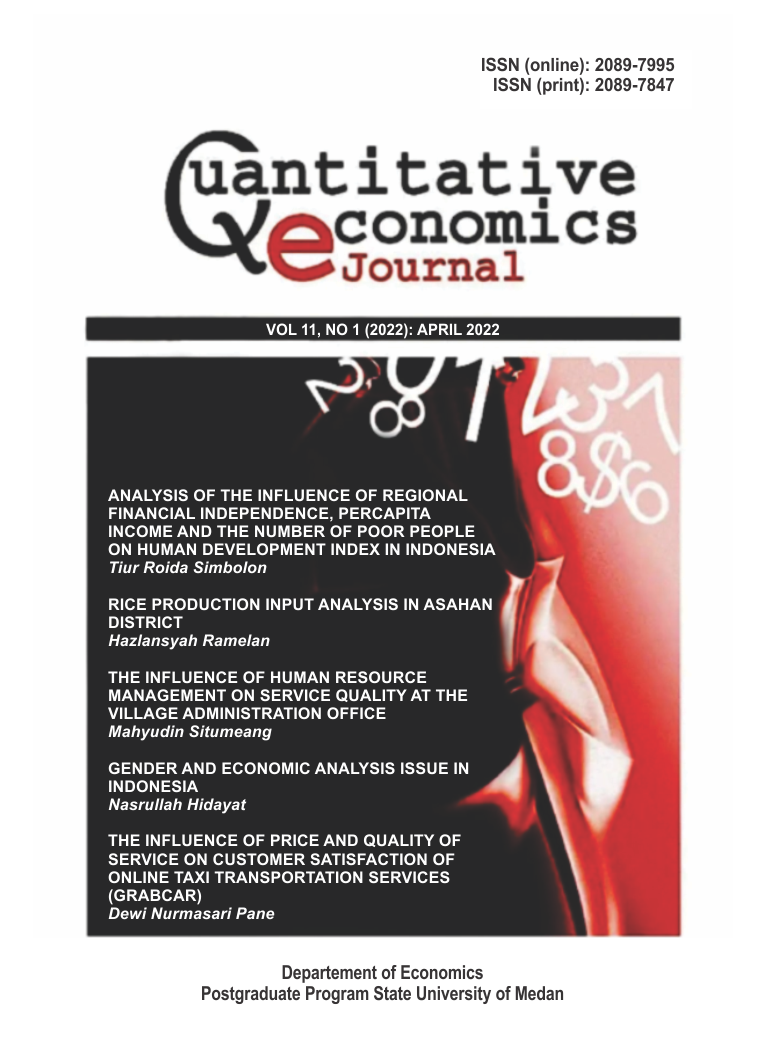GENDER AND ECONOMIC ANALYSIS ISSUE IN INDONESIA
DOI:
https://doi.org/10.24114/qej.v11i1.38425Abstract
The purpose of this paper is to study gender and economic analysis issue in Indonesia. Gender analysis provides the basis for carrying out social transformation to realize a new, better life order, through new, more just social relations. The results of this study suggest that In order to support women's empowerment in the economic and labor fields, the following programs were developed: 1) Gender mainstreaming in economic development and employment, 2) Empowering women in the development of the people's economy. Bsides that the ability of women in the field of entrepreneurship, in order to develop productive economic enterprises, increasing women's access to information on natural resources, capital resources, credit and market information, strengthening business partnerships managed by women with the private sector, BUMN, and cooperatives and renewal and improvement of labor laws and regulations for gender equality and justice.Keywords : Gender, Economics, WomenReferences
Akah, Fardus A. (2012). The Role of Gender in the Family: A Case Study of the Mandar Ethnic in the Tonyaman Coast. Accessed on November 25, 2012, from http://paudni.kemdiknas.go.id/bppnfi5/Note-157-en-peranan-gender-dalam- Keluarga.
Arivia, Girl. (2012). It's Women's Right Stupid!. Jakarta: Women's Journal vol. 17 No. 3, September 2012
Baden S. (2003). Gender, Governance, and the Feminization of Poverty. Jakarta: Center for Regional Information and Studies.
Cantor DW and Bernay T. (1992). Women in Power: The Secret of Leadership. Boston: Houghton Mifflin Company.
Hariski. 2011.Functions of Management Functions According to Experts.Accessed on November 25, 2012, from http://hariski.wordpress.com/2011/11/11/function-function-manajemen-menurut-para-ahli/
Hartini, Period. (2012). Women's Economic Empowerment: Out of Poverty. Jakarta: Women's Journal vol. 17 No. 3, September 2012
Huri, Daman et al. (2008). Democracy and Poverty. Malang: PLaCIDS Averroes and KID Democracy School Program.
Joekes, Susan. P. (1987). Women In The World Economy An Instraw Study. New York: Oxford University Press.
Ministry of Women's Empowerment and Child Protection of the Republic of Indonesia. (2011). Women and Home Industry. Deputy for PUG for Economic Affairs
Ministry of Women's Empowerment and Child Protection. Formal Sector Workers. Accessed on 27 November 2012, from http://menegpp.go.id/V2/index.php/datadaninformation/ketenagakerjaan
Kuntjaraningrat. (1990). Introduction to Anthropology. Jakarta: Publisher Rineke Cipta
Nurlaelatus Tsa'diyah. (2005). Pattern of Family Economic Management of Stone-breaking Women in Kradenan Baru Village, Bendan Duwur Village, Gajah Mungkur District, Semarang City Government. Semarang: Semarang State University.
Purba, Rasita Ekawati. (2007). The Importance of GPI (Gender And Proverty Inclusive). Senior Project Officer Monev/CL
Ruspita, Leli. (2012). The Alienation of Women from Their Work: A Husband-Wife Partnership in the Management of Household Finances. Jakarta: Women's Journal vol. 17 No. 3, September 2012
Sajogjo. (1985). The Role of Women in Village Community Development. Jakarta: Foundation for Social Sciences
Suparlan, Parsudi. (1993). Urban Poverty: Readings for Urban Anthropology. Jakarta: Indonesia Torch Foundation.
National Labor Force Survey. Central Bureau of Statistics 2004-2008, 2011
Toersilaningsih, Rani. (2012). Family Structure, Demographic-Economic and State Policy in Indonesia. Jakarta: Women's Journal vol. 17 No. 3, September 2012
Townsend, J. and Momsen, J. (1987). Toward a Geography of Gender in Developing Market Economies. In Geography of Gender in the Third World (JH Momsen and JGTownsend (eds.), pp. 27-81. London: Hutchinson.
Triwibowo, Darmawan. (2012). Vulnerability of Women in Natural Resource Management Conflicts in the Muria Area. Jakarta: Women's Journal vol. 17 No. 3, September 2012
World Development Report. (2012). Gender Equality and Development. The World Bank












